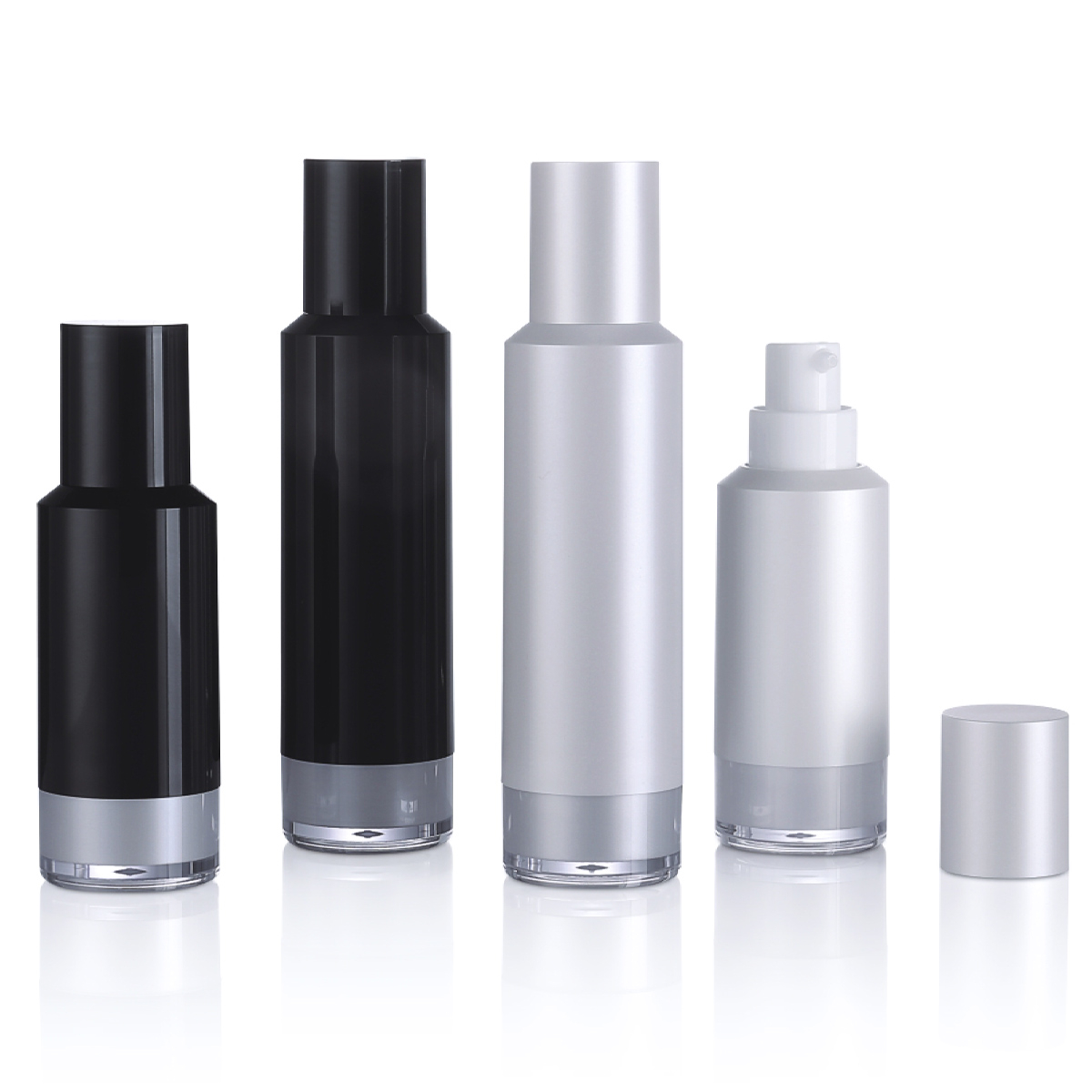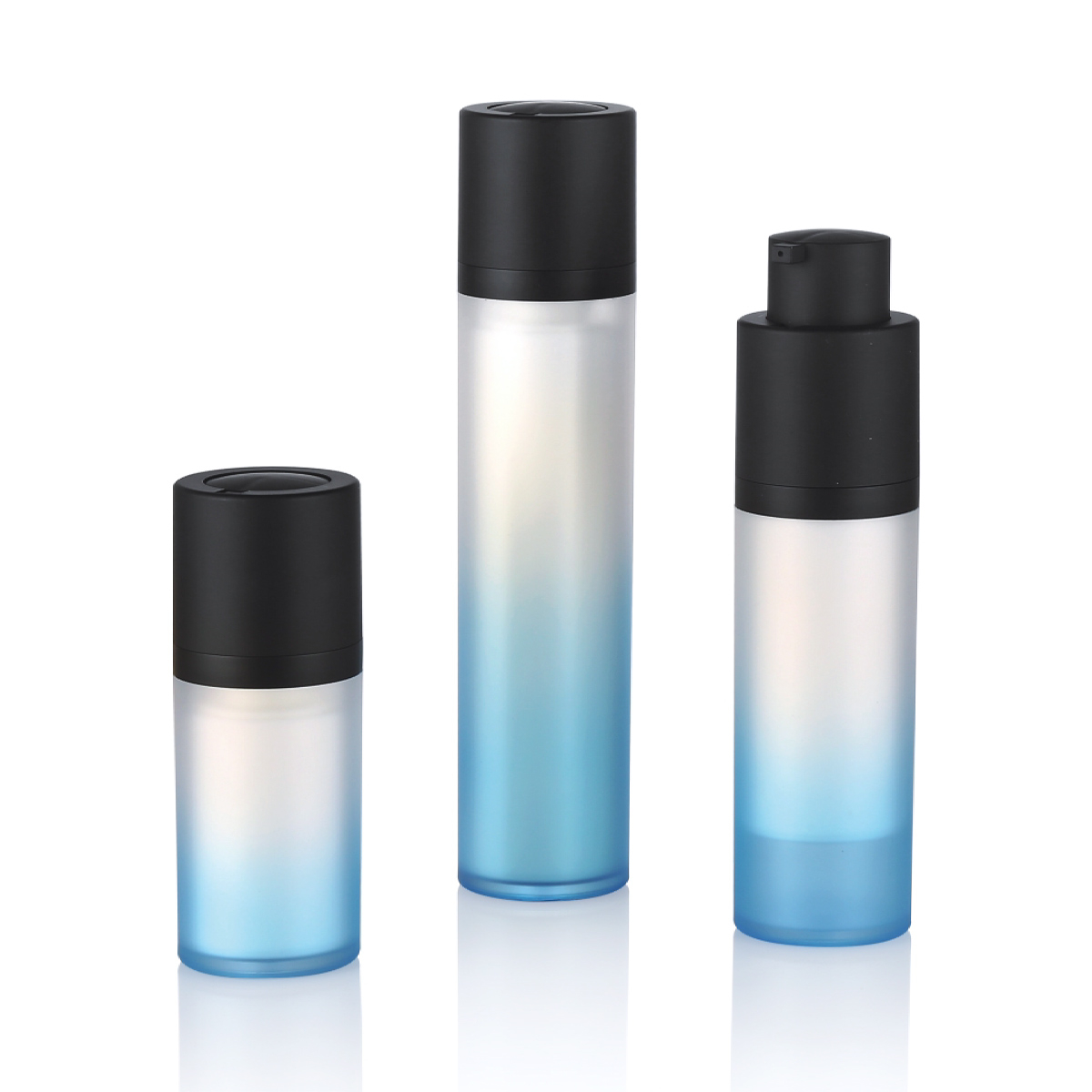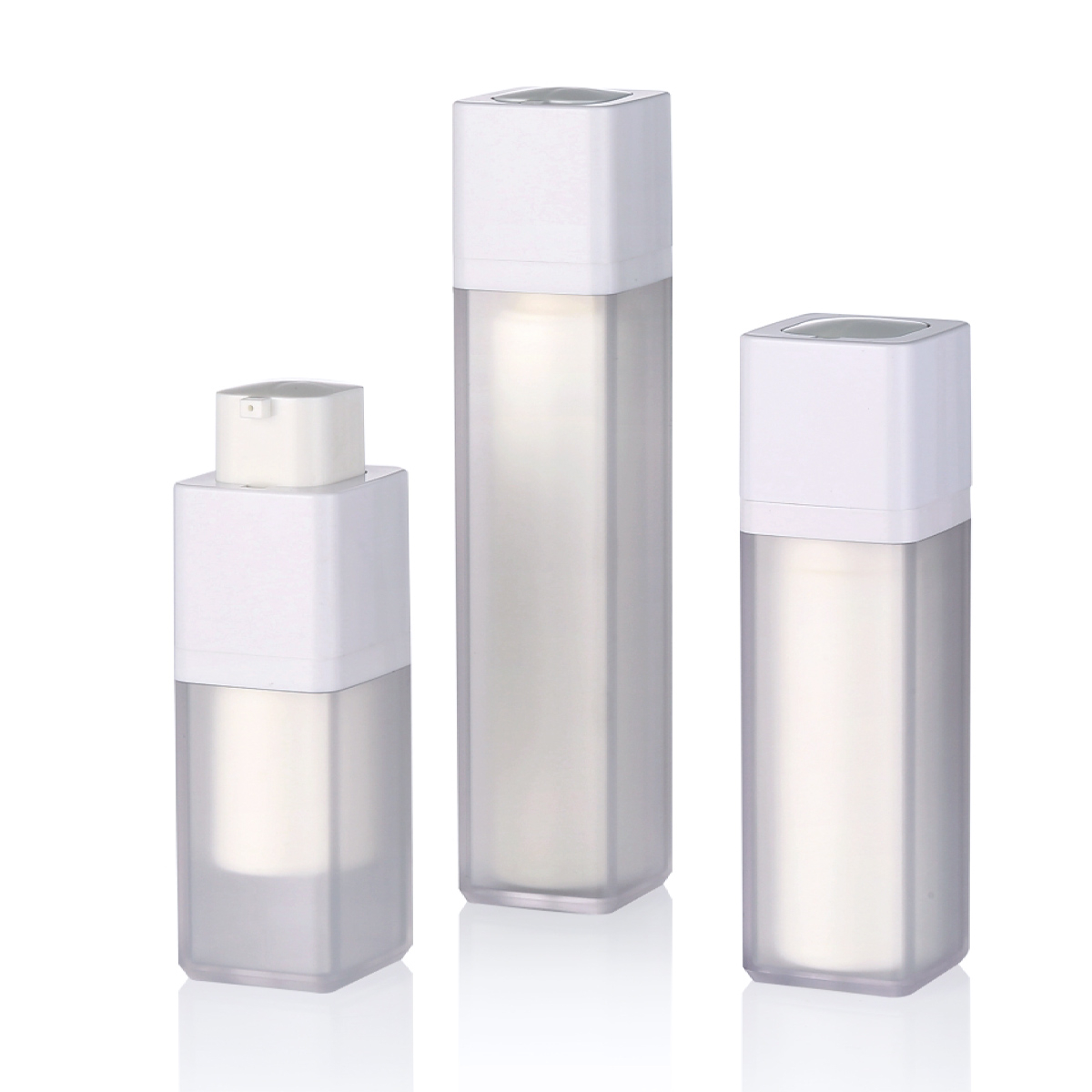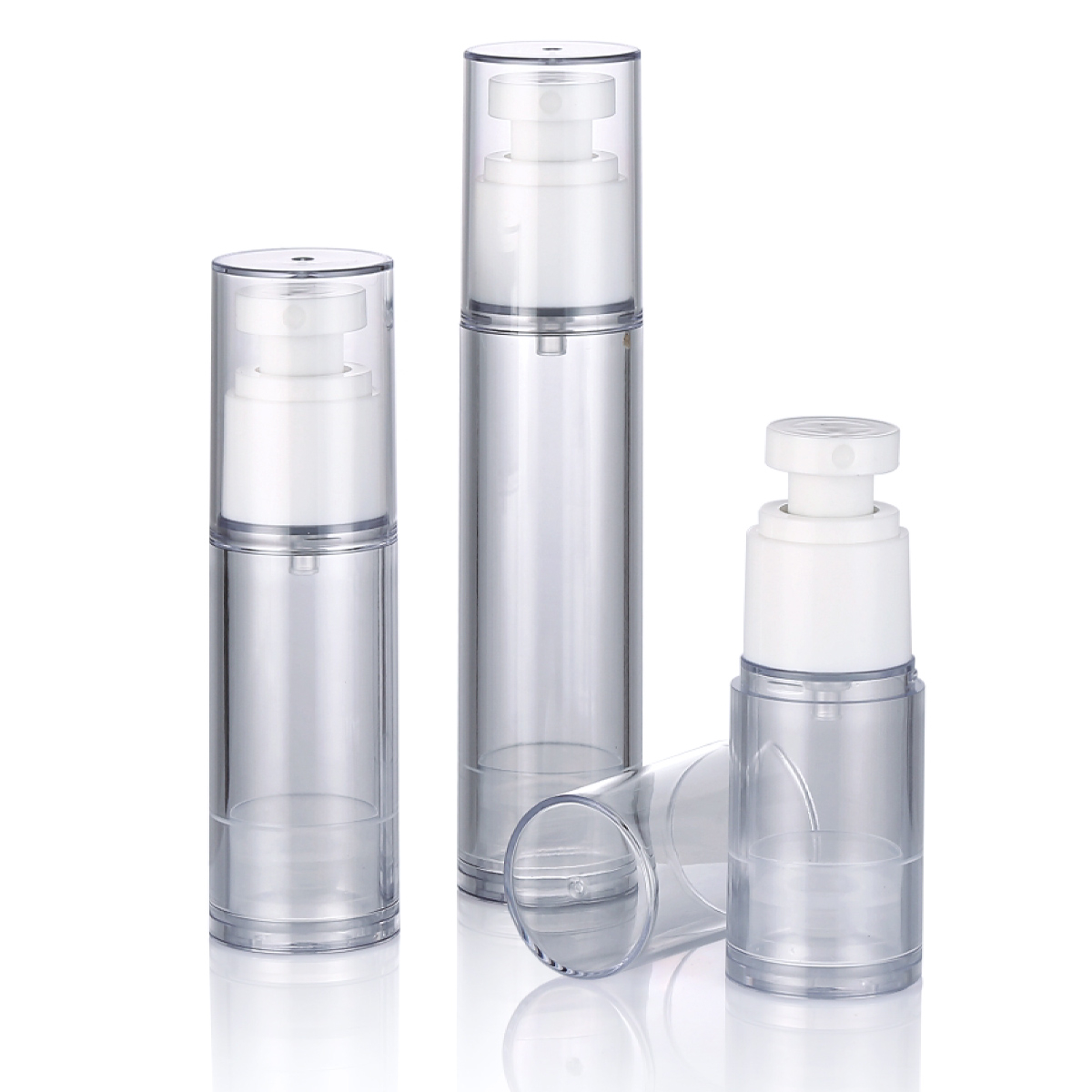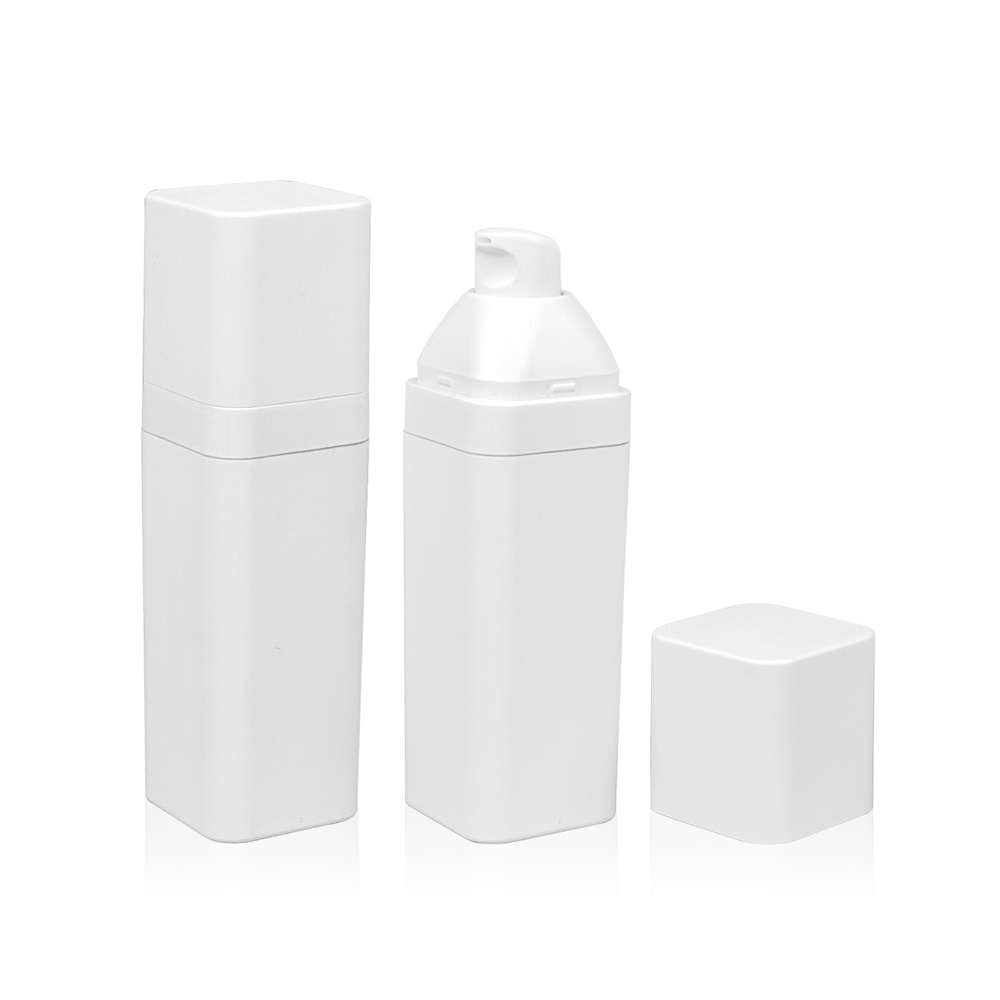I. Concept Analysis: What is a Vacuum Bottle?
Airless Bottle is not literally "airless", but refers to an advanced packaging system that completely isolates the contents from the external environment (air, bacteria, pollutants, etc.) through vacuum negative pressure and physical isolation principles. Its core goal is to provide ultimate protection: protect the activity and purity of product ingredients, protect consumers' safety and experience, and protect the brand's quality reputation.
It completely subverts the working mode of traditional wide-mouth bottles, dropper bottles, and even ordinary pump bottles. In traditional packaging, the contents are continuously exposed to air during use, leading to many problems such as oxidation, contamination, and inactivation of active ingredients. The unique structure of the vacuum bottle only discharges the product each time it is pressed, while preventing any external substances from flowing back into the bottle, creating a nearly closed pure environment.
Core Value Reflection:
Ultimate Freshness Preservation: The ultimate barrier against oxidation, photosensitivity, and loss of volatile ingredients.
Eliminate contamination: Physically isolate bacteria, dust, and finger contact to ensure the purity of ingredients and hygienic use.
Precise quantitative: Each press provides a stable and controllable dosage output to avoid waste.
Extreme utilization: Ultra-high utilization rate (usually >95%), very little residue at the bottom of the bottle, significantly better than traditional packaging.
Improve experience: Smooth pressing, textured design, and technological appearance meet high-end consumer needs.
Vacuum bottles represent a major leap in packaging technology in the fields of cosmetics, medicine, and high-end chemicals, and are a perfect fusion of science and aesthetics.
2. In-depth analysis: The core secret of vacuum bottles
1. Precision structure and operating principle (core engine)
The charm of vacuum bottles comes from its exquisite engineering design. The main components work together like a miniature precision instrument:
Outer Shell / Housing:
Material: Usually high-rigidity, high-transparency resins (such as PETG, AS, PMMA) or opaque/pearlescent masterbatch modified PP are selected. High-end products often use thick glass shells to enhance the texture.
Function: Contains internal components, shapes the appearance of the product, and provides structural support and protection. The transparent shell makes it easy to observe the remaining volume.
Inner Container / Cylinder:
Material: Usually made of PE (polyethylene) or PP (polypropylene) with excellent flexibility and barrier properties. It is the first layer of inner packaging that directly contacts the contents.
Function: As a soft container for holding products, the concave design of its bottom is the key. As the contents decrease, the bottom will continue to arch up under the action of atmospheric pressure and springs, pushing the piston.
Piston / Disc:
Material: High-density PE or special rubber material, with excellent sealing, chemical inertness and smooth sliding.
Function: One of the core driving components of the system. Located at the bottom of the inner liner, it fits tightly with the inner liner wall to form a sliding seal. Its core function is to divide the space inside the bottle into two parts: the lower part is the product to be used, and the upper part is the vacuum (or low pressure) area that is continuously formed with use.
Spring:
Material: Mainly stainless steel (304, 316L), ensuring corrosion resistance and long-term elasticity.
Function: The second core driving component of the system. Located below the piston or integrated in the base. Its function is to provide continuous and stable upward thrust. When the pump head is pressed to discharge the product, the restoring force of the spring immediately pushes the piston upward to fill the space left after the product is emptied and maintain the negative pressure in the bottle. The strength design of the spring is crucial and directly affects the pressing feel and emptying efficiency.
Pump Assembly:
Components: Including pump body, pressing head, valve (nozzle valve, outlet valve), spring (small), straw (optional). The pressing head is often made of PP, ABS or metal coating.
Function: The output control hub of the product. When pressed, the internal valve system opens, and the product is pressed out through the straw under the push of the piston; when released, the valve closes, and the air check valve (if any) prevents the external air from flowing back (but in the design of vacuum bottles, this valve is mainly used for the pump itself, and the negative pressure in the bottle is maintained by the piston seal). Its sealing is crucial to prevent the product from drying up and secondary contamination.
Base Cap / Bottom Plug:
Material: PP, ABS or metal.
Function: Encapsulate the bottom of the bottle, fix the spring position (if the spring is at the bottom), provide stable support, and serve as the assembly entrance. Usually not removable.
Protective cover (Over Cap):
Material: PP, ABS, metal or the same material as the shell.
Function: Protect the pump head from contamination, mis-pressurization and physical damage, lock the fragrance (especially perfume), and improve the overall aesthetics and integrity.
Workflow (dynamic vacuum maintenance):
Initial state: The bottle is full, the piston is at the bottom of the liner, and the spring is in a compressed or stored state.
Press the pump head: External force is applied, the valve inside the pump head opens, and the product is pushed out under the pressure of the piston. At the same time, the spring under the piston is further compressed (or the stored energy is released).
Release the pump head: The external force disappears, the pump head valve is closed (to prevent air backflow and product drying), and the piston is immediately pushed upward under the strong restoring force of the spring. The upward movement of the piston reduces the space at the bottom of the liner and fills the volume occupied by the discharged product.
Vacuum formation and maintenance: The upward movement of the piston causes the space above the piston in the bottle (the space occupied by the original product) to form a low pressure or even near vacuum state (because the sliding seal of the piston prevents external air from entering this area). At the same time, the spring under the piston continues to provide thrust to ensure that the piston is always close to the liquid surface (or paste).
Reciprocating: Repeat steps 2-4 for each press. The piston continues to rise, and the "vacuum chamber" above the piston in the bottle continues to expand until the piston reaches the top of the liner and the contents are almost completely discharged.
2. Key technologies and material science (the cornerstone of performance)
Precision sealing technology:
Piston-liner seal: This is the "lifeline" of the vacuum bottle. It requires extremely high sliding sealing performance, which must ensure smooth sliding under the thrust of the spring and no leakage or jamming during long-term use. Material compatibility, surface finish, and dimensional tolerance (usually at the micron level) are crucial. Special coatings (such as fluorine-containing coatings) can reduce the friction coefficient.
Pump head seal: The precise design of the valve system (such as ball valves, umbrella valves, duckbill valves) and the selection of elastomeric materials (such as silicone, TPE) ensure unidirectional flow and prevent the contents from drying up, air backflow, and bacterial invasion (i.e. "secondary contamination").
Integral sealing of the bottle: The joints between the shell and the base, and the pump head and the bottle mouth need to be precisely sealed (commonly used ultrasonic welding, hot melt, adhesive or mechanical snap + sealing ring).
Application of high-performance materials:
Barrier materials: For products that are highly active, easily oxidized, or sensitive to water vapor, the liner or shell will use high-barrier co-extruded materials (such as PE/EVOH/PE), or add barrier masterbatch to PP/PE.
Compatible materials: All parts that come into contact with the contents (liner, piston, pump head internals, straw) must pass strict compatibility tests (migration test, adsorption test, stability test) to ensure that they do not affect the product efficacy and safety, and are not corroded or swollen by the product. Compatibility tests need to be conducted for specific formulas.
Durable materials: The spring must be made of medical-grade stainless steel; the shell must be impact-resistant and scratch-resistant; the pump head spring must be fatigue-resistant.
Spring mechanical design:
The spring stiffness coefficient (k value), free length, and working stroke must be precisely calculated to provide a constant and moderate thrust. If the thrust is too small, the piston cannot follow up in time, resulting in failure to press or the appearance of a "cavity"; if the thrust is too large, the pressing resistance will increase or even damage the liner. Optimized design ensures that the pressing feel from full bottle to empty bottle is basically the same.
Advanced manufacturing process:
Precision injection molding and blow molding: High-precision molds (usually require slow wire processing) ensure component dimensional stability and sealing surface finish. Multi-cavity molds improve efficiency.
Automated assembly: Automated assembly in a clean workshop (usually requires Class 10,000 or Class 100,000) to reduce human contamination and errors. The assembly process involves key steps such as spring pre-compression, piston positioning, and pressure testing.
Online detection: Integrated sealing test (negative pressure test/positive pressure test), press test, appearance inspection, etc., to ensure 100% yield rate.
3. Unparalleled core advantages (market driving force)
Revolutionary preservation, defending activity:
Eliminate oxidation: Completely isolated from oxygen, it is the "guardian" of easily oxidized and inactivated ingredients such as vitamin C, vitamin A (retinol), peptides, plant extracts, and essential oils. Experiments have shown that under the same conditions, the activity retention rate of vitamin C solution stored in vacuum bottles is more than 50% higher than that of traditional bottles.
Blocking photosensitivity: The opaque shell (or the use of dark/UV blocking materials) can effectively prevent ultraviolet rays from destroying photosensitive ingredients (such as retinol, certain VC derivatives, and fruit acids).
Preventing volatility: The closed system prevents volatile ingredients (such as alcohol, fragrances, and active solvents) from escaping, maintaining product concentration and usage experience.
Ultimate protection, pure and worry-free:
Physically isolated from pollution: Air, dust, and microorganisms (bacteria, mold) cannot enter the bottle, and consumers' fingers will not touch the product in the bottle. Passing the ISO 11930 standard test, it is proved that it can effectively inhibit the growth of microorganisms, significantly reduce the amount of preservatives (such as Parabens), and even achieve "self-preserving", catering to the trend of clean beauty.
Preventing secondary pollution: The one-way output design and the pump head valve prevent backflow, ensuring that each time you take out a fresh product that has not been exposed to air, avoiding the problem of discoloration and deterioration of the paste caused by bottle mouth contamination.
Ultra-high utilization rate, no waste:
The piston's continuous follow-up design can almost completely push out the paste/liquid in the bottle. The utilization rate is generally higher than 95%, and can even reach 99%, which is much higher than wide-mouth bottles (~25% residue), hoses (~10%) and ordinary pump bottles (~15%). For expensive essences (such as caviar essence, high-concentration prototype VC), ointments or limited products, saving is of great significance.
Precise quantitative, experience improvement:
The dosage output for each press is highly consistent (the error is usually controlled within ±5%), which is convenient for users to accurately control the dosage (such as products requiring a specific concentration of retinol), avoid waste or irritation caused by excessive use, and also facilitate following the instructions for use. Compared with the dropper (the fluctuation of the amount of each absorption can reach ±20%), the advantage is obvious.
Silky pressing experience: The optimized spring and pump head system provides a comfortable, labor-saving, and consistent damping feeling, which improves the pleasure of use.
Strong universality of contents:
It can perfectly adapt to almost all dosage forms, from water-based essences, lotions, creams, gels, mud masks to high-viscosity BB creams, foundation liquids, sunscreens and even particle-containing scrubs. By adjusting the pump head aperture, valve design and spring strength, the output volume and form (spray, emulsion, paste) can be precisely controlled.
Enhance product value and brand image:
The vacuum bottle conveys a sense of technology, high-end, professionalism, safety and the ultimate pursuit of quality, becoming a strong support for brand premium. The exquisite appearance design (frosted, metal plating, curved surface modeling, personalized cap) makes it a work of art on the dressing table.
4. Wide range of application areas (not just beauty)
Skincare: This is the largest and most mature application market for vacuum bottles.
Serums: The preferred packaging for highly active and high-value essences, especially vitamin C, vitamin A (retinol/retinaldehyde/retinol ester), peptides, growth factors, antioxidant complexes, etc.
Creams/Lotions: The mainstream choice of mid-to-high-end anti-aging, whitening, and repairing creams and lotions, protecting the activity of ingredients and ensuring hygiene.
Eye Creams: Small volume, high unit price, more precise dosage and hygiene protection are required. Vacuum bottles are more gentle to press, suitable for the fragile eye area.
Sunscreen: Protect sunscreens (especially organic sunscreens) from photodegradation and maintain the stability of SPF/PA values. The press design also facilitates sufficient application.
Special care: Acne products (prevent bacterial contamination), whitening and spot-lightening essences (protect unstable ingredients), and ampoule essences for subsequent maintenance packaging.
Makeup:
Foundation/BB/CC Cream: Provide hygienic use, precise dosage control, and prevent oxidation and discoloration (especially organic makeup without preservatives or with less preservatives). The press design is also better than wide-mouth bottles and droppers.
Primers: Protect ingredients and accurately take the amount.
Concealers: Small-volume, high-coverage products require a clean and hygienic way of taking.
Pharmaceuticals & Dermocosmetics:
Prescription ointments: For ointments for treating eczema, psoriasis, and acne, vacuum bottles provide a sterile or low-bacteria environment, accurate dosage, and avoid cross-infection.
Scar repair gel/ointment: Protect active ingredients (such as silicone, onion extract) and apply accurately.
Local analgesic/anti-inflammatory gel: Such as diclofenac sodium gel.
High-concentration medical ingredient skin care products: Such as prescription-grade Tretinoin and hydroquinone (HQ) preparations.
Personal Care & Home Care:
High-end hand soap/shower gel: Improve the experience and grade, and reduce the residue at the bottom of the bottle.
High-value shampoo/conditioner essence: Protect the activity of hair care ingredients.
Pet medicinal dressing: Ensure efficacy and hygiene.
Precision adhesive/lubricant: Isolate air moisture, prevent solidification, and dispense accurately.
5. Challenges and development trends (future road)
Challenges and limitations:
High cost: Complex structure, high material requirements, and precise manufacturing process result in a unit price significantly higher than ordinary packaging (such as hoses, cans, and ordinary pump bottles). It is the choice of high-value products.
Assembly complexity: There are many components, large investment in automated assembly lines, and more quality control points.
Capacity limitation: Due to the space occupied by the internal structure (spring, piston travel area), the effective capacity is usually smaller than that of ordinary containers with the same external dimensions. Large-capacity (>200ml) design is more challenging and the cost increases sharply.
Residue problem: Although the utilization rate is high, in theory, there may still be trace amounts of residues that cannot be discharged between the top of the piston and the inner wall and at the end of the straw (about 1-5%, depending on the design).
Pump head matching: The pump head characteristics (spray, emulsion, paste) need to perfectly match the product viscosity, otherwise it will affect the user experience.
Recycling complexity: Multiple layers of materials (shell, liner, pump head metal spring, sealing ring) are combined, making separation and recycling difficult, increasing environmental pressure.

 English
English 中文简体
中文简体 Español
Español عربى
عربى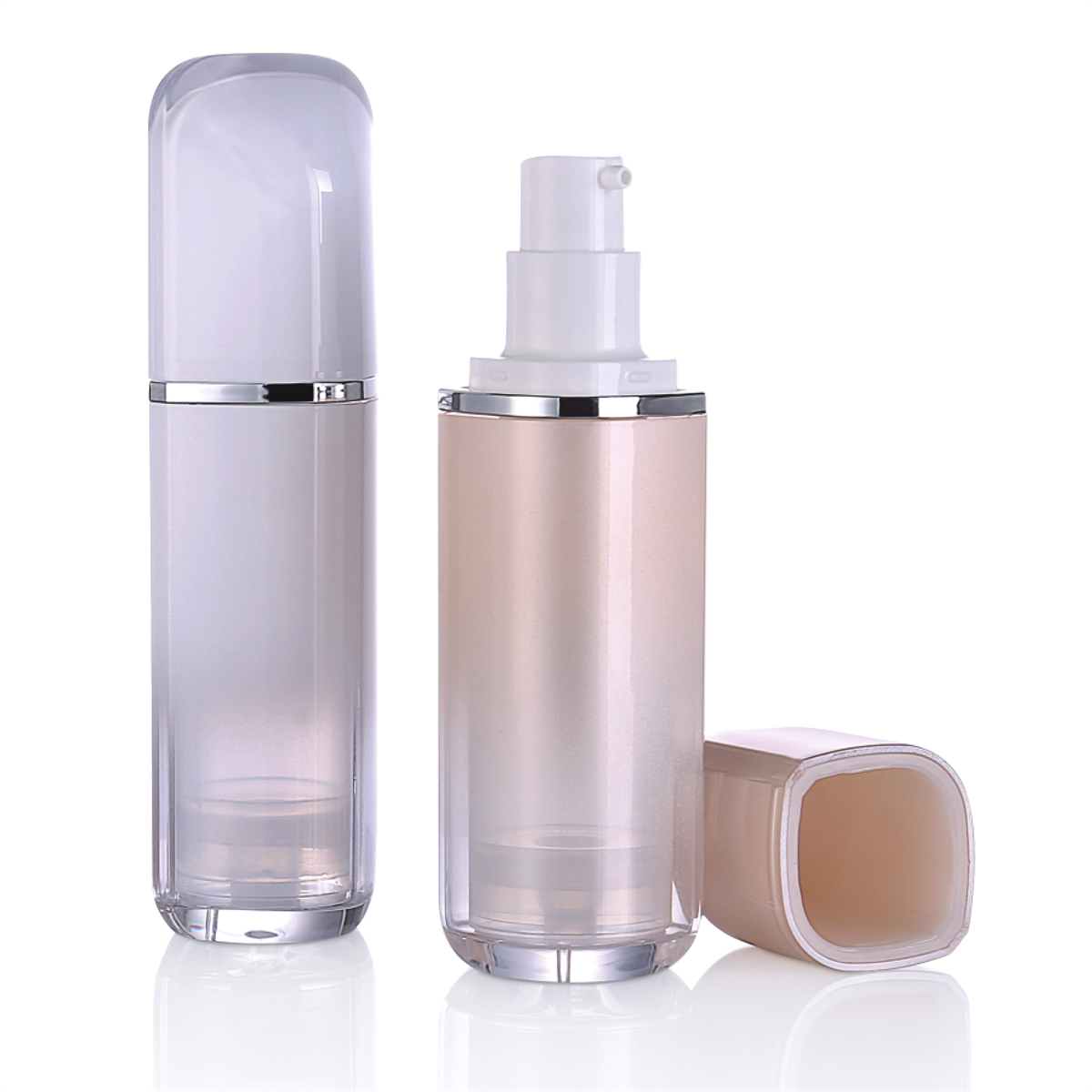
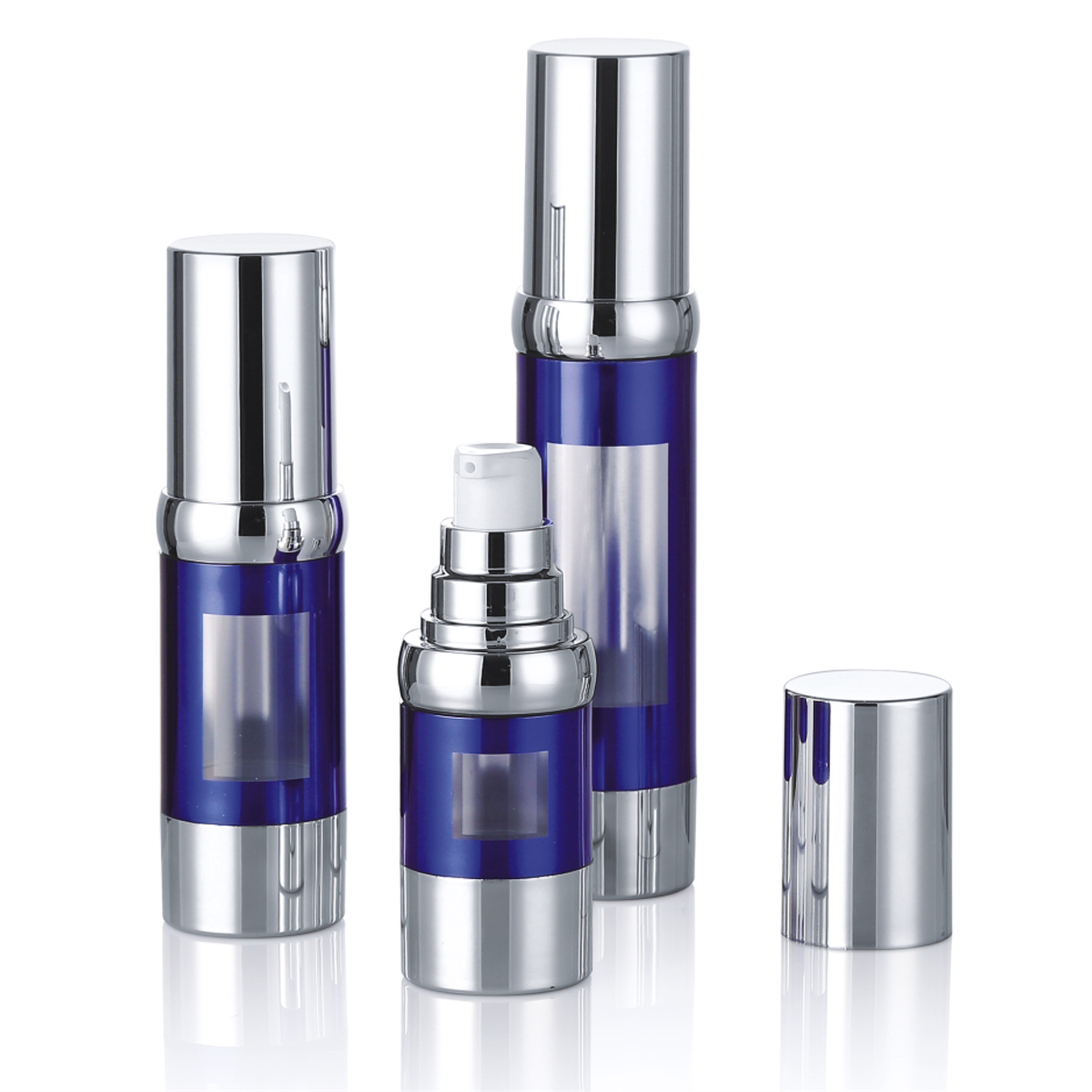
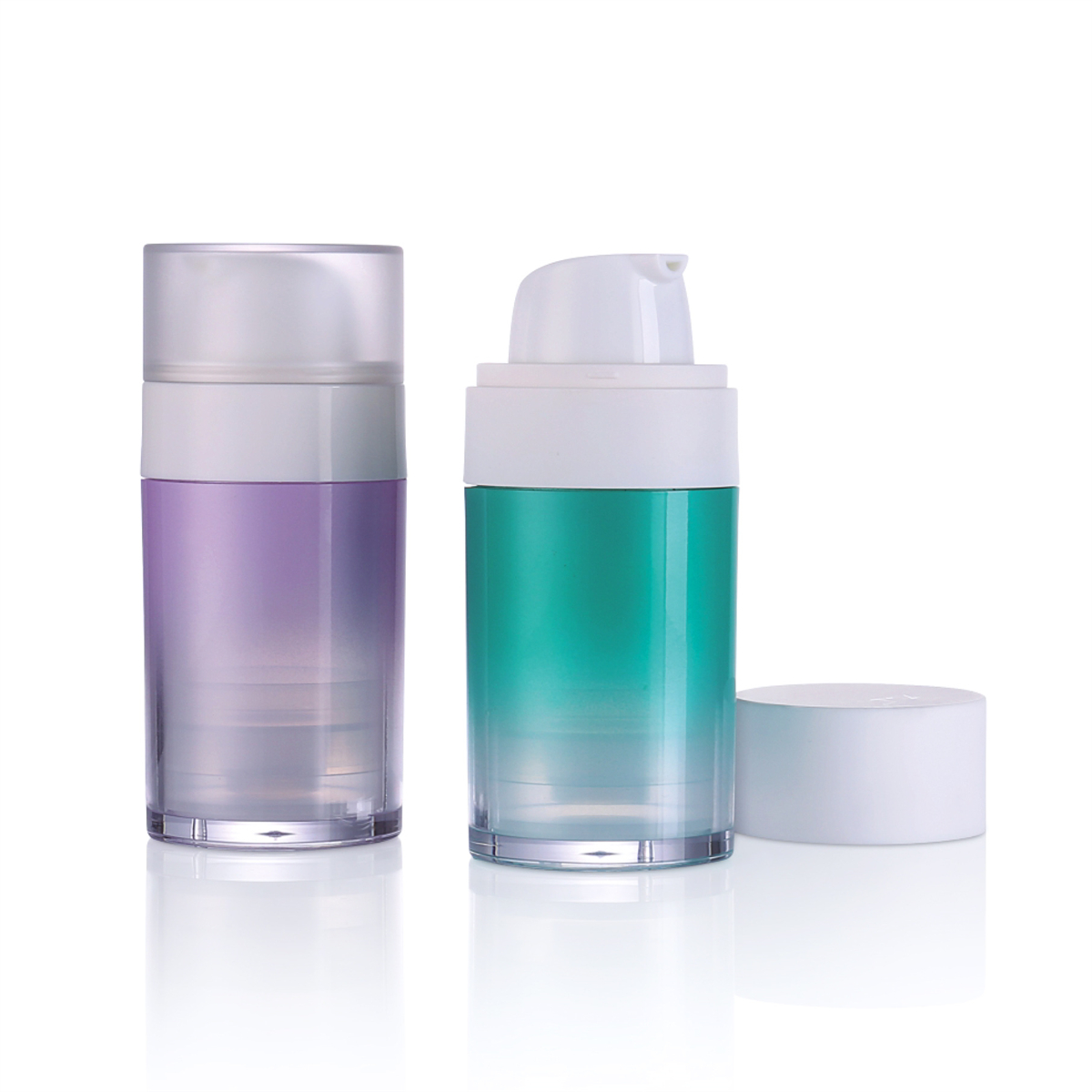

.jpg)
